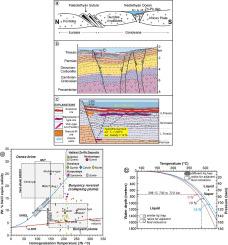当前位置:
X-MOL 学术
›
Ore Geol. Rev.
›
论文详情
Our official English website, www.x-mol.net, welcomes your
feedback! (Note: you will need to create a separate account there.)
Geological, Geochemical and Microthermometric Characteristics of the Hakkari Region Zn-Pb Deposits, SE Turkey
Ore Geology Reviews ( IF 3.2 ) Pub Date : 2020-10-01 , DOI: 10.1016/j.oregeorev.2020.103667 Nurullah Hanilçi , Hüseyin Öztürk , David Banks
Ore Geology Reviews ( IF 3.2 ) Pub Date : 2020-10-01 , DOI: 10.1016/j.oregeorev.2020.103667 Nurullah Hanilçi , Hüseyin Öztürk , David Banks

|
Abstract The Hakkari region in SE Turkey contains large Zn-Pb deposits, primarily of non-sulfide ore in Upper Triassic passive margin carbonates. In the Karakaya, Meskantepe and Uzumcu Zn-Pb deposit, the 3 main and >15 ore layers alternate with a thick-bedded limestone. The feeder in the region veins are well defined, containing both non-sulfide and sulfide ore. Primary sulfide ore contains between 1 and 37 % Zn, has transformed to “non-sulfide” ore containing Zn > 10%. Both non-sulfide and sulfide ore is associated with As, Se, Hg, Tl, Mn and Sb, which is similar to other SEDEX deposits. The average δ34S of the stratiform and feeder zone sulfides are 2.1‰ and 1.67‰, respectively. Sulfur isotope data of sphalerite, galena and pyrite (from −3.4 to 8.8‰) indicates that sulfur came from a homogeneous large source. Sulfate was reduced by the process of thermochemical sulfate reduction (TSR) rather than bacterial sulfate reduction (BSR). Lead isotope values (206Pb/204Pb ≈ 18.49, 207Pb/204Pb ≈ 15.66 and 208Pb/204Pb ≈ 38.69) reflect an evolved upper crustal source. The homogenisation temperature (Th) and salinity of fluid inclusions is from 165 to 289 °C, and from 1 to 22% equiv. NaCl salinity. Such a wide range of Th and salinity, and Cl/Br ratio (409 from sphalerite and galena; 662 from barite) of fluid inclusions may indicate mixing of basinal brines and seawater. Successive ore levels, laminated with shale-carbonate rich in organic matter, formed on the seafloor as banded and replacement ore. Trace element associations, fluid inclusion and isotope data indicate that the Zn-Pb deposits were formed as synsedimentary processes associated with feeder systems during the initiation of the Triassic rifting as a vent-proximal SEDEX-type. The metals (Pb, Zn, Fe) were leached from Palaeozoic and older clastic rocks in the Arabian platform by seawater sourced fluids, and ascended through deep fractures. The metalliferous fluids should have formed vein type mineralization in feeder zone, sub-seafloor replacement type ore under the ocean floor, and stratiform ore on the seafloor.
中文翻译:

土耳其东南部 Hakkari 地区锌铅矿床的地质、地球化学和微量测温特征
摘要 土耳其东南部的 Hakkari 地区包含大型 Zn-Pb 矿床,主要是上三叠统被动边缘碳酸盐岩中的非硫化矿。在 Karakaya、Meskantepe 和 Uzumcu Zn-Pb 矿床中,3 个主矿层和 >15 个矿层与厚层石灰岩交替。该地区矿脉中的馈线清晰,包含非硫化物和硫化物矿石。原生硫化矿含有 1% 到 37% 的 Zn,已转变为含有 Zn > 10% 的“非硫化物”矿石。非硫化物和硫化物矿石都与 As、Se、Hg、Tl、Mn 和 Sb 伴生,这与其他 SEDEX 矿床相似。层状和供给带硫化物的平均δ34S分别为2.1‰和1.67‰。闪锌矿、方铅矿和黄铁矿的硫同位素数据(-3.4 到 8.8‰)表明硫来自同质的大来源。通过热化学硫酸盐还原 (TSR) 而非细菌硫酸盐还原 (BSR) 过程来还原硫酸盐。铅同位素值(206Pb/204Pb ≈ 18.49、207Pb/204Pb ≈ 15.66 和 208Pb/204Pb ≈ 38.69)反映了演化的上地壳源。流体包裹体的均质温度 (Th) 和盐度为 165 至 289 °C,1 至 22% 当量。氯化钠盐度。流体包裹体中如此广泛的 Th 和盐度以及 Cl/Br 比(闪锌矿和方铅矿为 409;重晶石为 662)可能表明盆地卤水和海水混合。连续的矿石层与富含有机质的页岩碳酸盐层合,在海底形成带状和替代矿石。微量元素关联,流体包裹体和同位素数据表明,在三叠纪裂谷作为近喷口 SEDEX 型裂谷开始期间,Zn-Pb 矿床是作为与馈源系统相关的同沉积过程形成的。金属(Pb、Zn、Fe)通过海水来源的流体从阿拉伯台地的古生代和较老的碎屑岩中浸出,并通过深裂缝上升。含金属流体应在馈线区形成脉状矿化,在洋底下形成海底下置换型矿,在海底形成层状矿。
更新日期:2020-10-01
中文翻译:

土耳其东南部 Hakkari 地区锌铅矿床的地质、地球化学和微量测温特征
摘要 土耳其东南部的 Hakkari 地区包含大型 Zn-Pb 矿床,主要是上三叠统被动边缘碳酸盐岩中的非硫化矿。在 Karakaya、Meskantepe 和 Uzumcu Zn-Pb 矿床中,3 个主矿层和 >15 个矿层与厚层石灰岩交替。该地区矿脉中的馈线清晰,包含非硫化物和硫化物矿石。原生硫化矿含有 1% 到 37% 的 Zn,已转变为含有 Zn > 10% 的“非硫化物”矿石。非硫化物和硫化物矿石都与 As、Se、Hg、Tl、Mn 和 Sb 伴生,这与其他 SEDEX 矿床相似。层状和供给带硫化物的平均δ34S分别为2.1‰和1.67‰。闪锌矿、方铅矿和黄铁矿的硫同位素数据(-3.4 到 8.8‰)表明硫来自同质的大来源。通过热化学硫酸盐还原 (TSR) 而非细菌硫酸盐还原 (BSR) 过程来还原硫酸盐。铅同位素值(206Pb/204Pb ≈ 18.49、207Pb/204Pb ≈ 15.66 和 208Pb/204Pb ≈ 38.69)反映了演化的上地壳源。流体包裹体的均质温度 (Th) 和盐度为 165 至 289 °C,1 至 22% 当量。氯化钠盐度。流体包裹体中如此广泛的 Th 和盐度以及 Cl/Br 比(闪锌矿和方铅矿为 409;重晶石为 662)可能表明盆地卤水和海水混合。连续的矿石层与富含有机质的页岩碳酸盐层合,在海底形成带状和替代矿石。微量元素关联,流体包裹体和同位素数据表明,在三叠纪裂谷作为近喷口 SEDEX 型裂谷开始期间,Zn-Pb 矿床是作为与馈源系统相关的同沉积过程形成的。金属(Pb、Zn、Fe)通过海水来源的流体从阿拉伯台地的古生代和较老的碎屑岩中浸出,并通过深裂缝上升。含金属流体应在馈线区形成脉状矿化,在洋底下形成海底下置换型矿,在海底形成层状矿。











































 京公网安备 11010802027423号
京公网安备 11010802027423号